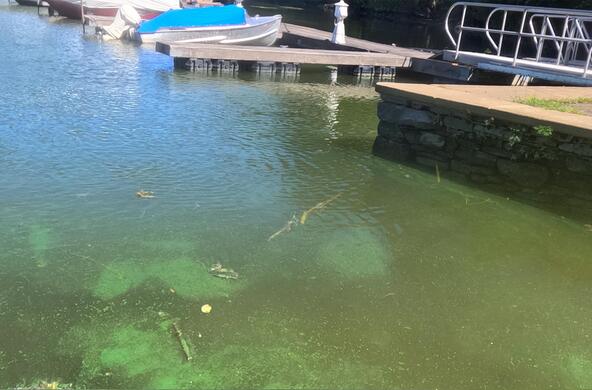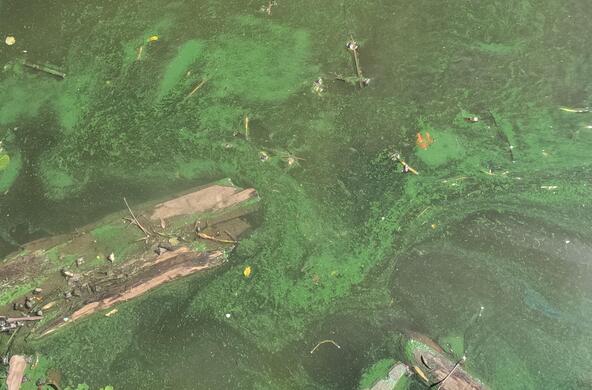A few weeks ago, during the night, a high tide deposited fistfuls of water celery upon the Lighthouse dock. The plant grows underwater with long, narrow leaves like slender green ribbons, looking nothing like the celery we eat. It's often called eelgrass, but it's not the same as saltwater eelgrass, which is a different plant. This is a native freshwater species, Vallisneria americana, that grows in the tidal flats of the Hudson River. Easily overlooked, this submerged vegetation is an important component of the estuary ecosystem. The sudden appearance of this plant tossed by the tide and strewn on the dock was an encouraging sign. Call it "good tidings."
Water celery has been noticeably absent for the past several years. In summer 2012, it became apparent that something was amiss. The plant was not found in spots where it previously had been prolific. Downstream neighbor Dock Shuter noticed on his daily rowing excursions that the Saddlebags and other Glasco flats were barren. Widening his search, he was unable to locate water celery on Green Flats offshore from Malden. None was to be found in the flats near the Lighthouse around the mouth of Esopus Creek. We wondered, is this an isolated phenomenon or something visible on a wider scale in the river valley?
To investigate, we went farther afield. By commandeering the sailboat of turn-of-the-century keeper Dick Duncan, we traveled upriver to the North Germantown boat launch. This used to be one of the most expansive beds of wild celery along the river. Results: barren flats, no submerged vegetation, nothing but sandy bottom. The findings were similar farther north at the mouth of the Roeliff-Jansen Kill: no plants growing on river-bottom, just a few sprigs of uprooted water celery drifting at the surface. Surely they survived somewhere.
More conclusive observations came from volunteers for the Submerged Aquatic Vegetation (SAV) project of the Cary Institute of Ecosystem Studies. Each year, volunteers in kayaks or canoes paddle to established spots to monitor the presence of SAV, primarily water celery, in the Hudson River, pinpointing their locations with GPS units. As the volunteers reported their data for 2012, a larger picture of the situation emerged. Of the sites monitored, the vast majority had no SAV present. The water celery had all but disappeared from the Hudson River. Tidal flats that were once lush and thick with vegetation were now mysteriously bare.
What could cause such sudden and sweeping change? The culprits: the infamous duo of Irene and Lee. In 2011, the back-to-back tropical storms delivered a one-two punch to the river. As flood waters poured into the river valley, the combined runoff carried about five times the average annual sediment in less than one month. According to estimates by the U.S. Geological Survey, sediment deposited into the Hudson River from swollen tributaries was approximately 2.7 million tons. Most of it was retained in the tidal river and did not travel seaward.
Subsequently, we noticed the scarcity of underwater vegetation. Apparently, much of the storm-driven sediment settled in the tidal flats, burying water celery under several inches of sand and silt, smothering the plants. Also, the high flows swept away plants and seeds, washing them down the river. Little was left over to sprout the following year. This appears to be the most plausible explanation for the widespread disappearance of water celery in the Hudson River estuary.
Why is this such a source of worry? The submerged plants are important components of the estuary. The beds of water celery are nurseries for young fish and food for waterfowl. They are water filters, trapping suspended sediments. They enrich the water with oxygen through photosynthesis. Like an underwater forest for aquatic life, they shelter diverse invertebrate organisms, fish and wildlife. The absence of water celery from the estuary could have broad repercussions on the ecological web.
In the summer of 2012, the situation was bleak. Dr. Stuart Findlay, aquatic ecologist for the Cary Institute of Ecosystem Studies, remained guardedly optimistic, saying, "I suspect the solution is simply patience." Dr. Erik Kiviat, executive director of Hudsonia, concurred: "Wild celery is tough and it will come back, I've no doubt."
Now, four years after the storms, there are convincing signs of recovery, albeit a slow one. In early July, the Hudson River Almanac heralded evidence of water celery returning to key locations in the estuary. While sampling for fish at North Germantown, Tom Lake, naturalist for NYSDEC's Hudson River Estuary Program, noticed wild celery "rooted in the shallows where there had been none last year." Searching for SAV at Cheviot, Dr. Findlay, reported, "Here, as well as North Germantown three miles upriver, we found excellent examples of healthy patches of wild celery." Dr. Kiviat also had good news to share: "I have found many patches of wild celery in Tivoli North Bay as well as 20 miles upriver in the southern portion of Hudson North Bay."
These initial reports of the regrowth of water celery are promising but are not the full story. For instance, little has regrown around the mouth of the Esopus Creek. "There are certainly sites that have come back but there are also many that haven't," Dr. Findlay wrote in an email, concluding that "assessment of the whole-system recovery will have to wait." Where the water celery recovers first may depend on localized conditions: variations in sediment loads, sediment composition (silt or sand), water quality, or other variables. "I think the species has persisted, or is recovering well, in the marsh creeks and pools." These patches of water celery regrowth may help propagate the species for recovery in other locations. "I expect it is slowly re-colonizing the more exposed areas of the main river," Dr. Kiviat wrote.






